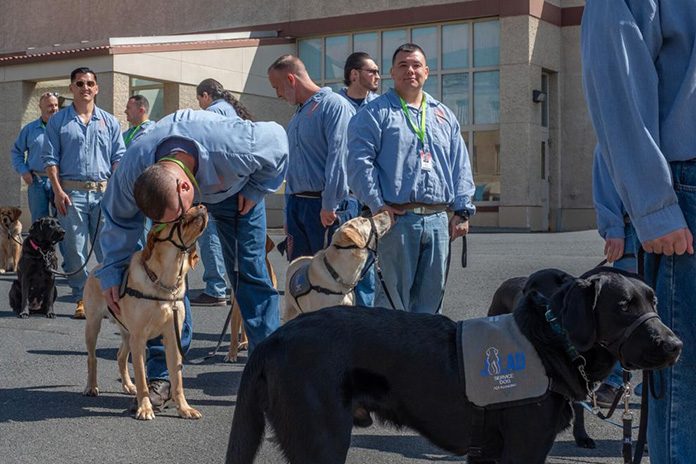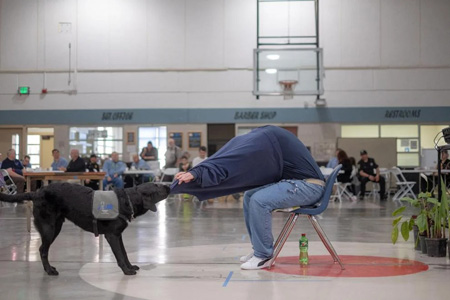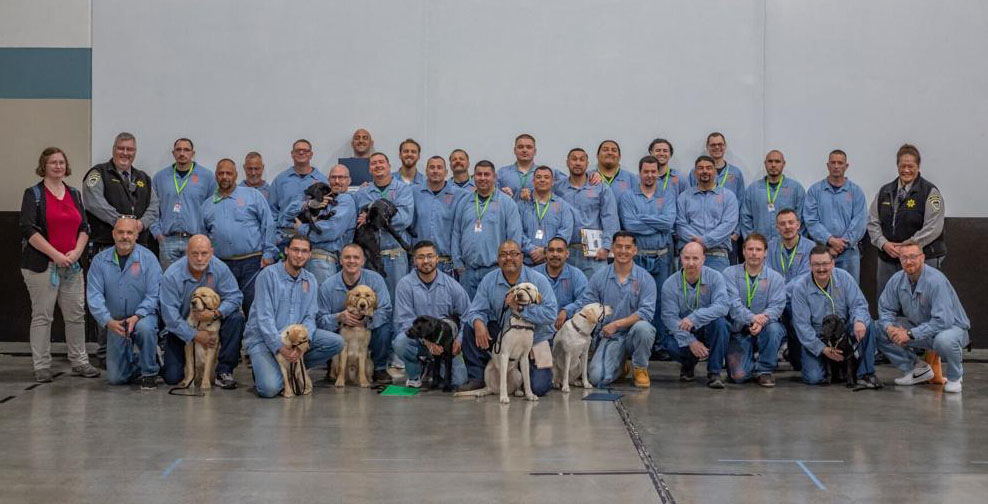
Thirteen people met the service dogs who will change their lives Monday, April 8, during a “Leash Passing Ceremony” at Eastern Oregon Correctional Institution, Pendleton.
The twice-yearly ceremony was the culmination of 18 months to two years of work by incarcerated handlers with the Joys of Living Assistance Dogs program inside the prison and a set of socializers who live on the outside, all of whom train and prepare the dogs to help people manage physical disabilities, post-traumatic stress disorder and more.
When dogs complete their training, the men incarcerated in EOCI who are part of the program host the recipients as well as their loved ones and other people involved in the program to pass the leash from the handlers to the new owner.
“It’s a very proud moment and very bittersweet to have to say goodbye,” said JLAD founder Joy St. Peter, “but knowing what they’re doing is absolutely amazing and it’s because of these guys that makes it so heartfelt.”
St. Peter said the ceremony always is heartfelt and unique because the dogs, handlers, recipients and speakers differ each time.
“The guys put their heart and soul into it, it’s just amazing,” she said, “so to see that vulnerable side of themselves, it just never gets old.”
The event gave the 34 men a chance to see who their beloved dogs will be helping. It also offered the people receiving the dogs an opportunity to thank those who have put in constant care and effort to train their new companion.
Budding relationships
On April 8, 13 new relationships began, including that of Erika Jones and her new service dog, Patty. Jones, 55, suffers from complex PTSD, and teared up after the ceremony as she thought about what having Patty around will mean for her.
“When I get overwhelmed, she distracts me and comforts me, or will,” she said. “She already does. This has been a big event for both of us.”
Jones lives in Portland, and Patty is her first service dog. She waited for a year and a half to get Patty.
“For me, I haven’t really had a support system my whole life, and the people who I thought were there to support me, didn’t,” Jones said, “so what Joy does with JLAD is, she’s preparing these animals to be supports for people who don’t have supports, so I’m just so grateful.”
Clint Hylton was one of the handlers who worked with Patty. After the ceremony, he helped introduce Jones to a few of the basic cues Patty knows. Patty will be able to help Jones through panic attacks, PTSD episodes and more.
Now that the leash has passed to Jones, she will start her own training process with Patty to learn all the cues and build a relationship with her dog.
Finding a purpose
The graduating dogs learn nearly 100 cues before graduation. During the ceremony, handlers showed the progression of one command at dogs’ various ages and stages of training.
The Get Help command starts with puppies learning that saying “Help” means they should make eye contact with the nearest person. Then, as they age, they learn to go find another person. Eventually, they lead that person back to their handler.

By the end of their training, the dogs herd the person they find to their handler, returning to the person repeatedly to make sure they reach the handler. They even know to go get help without the command if their handler is unresponsive.
Paul Adric served as the master of ceremonies. He moved the ceremony along, talking about the significance of the training and introducing the various speakers, including Victoria Venard, a 2022 recipient.
Venard shared some of her experience with PTSD, which causes her to have nightmares and flashbacks, losing track of time and her location. Before receiving her dog, Eva, Venard told the audience she couldn’t keep a full-time job. She was sleeping whenever she wasn’t working.
But now, less than two years later, she feels like she’s doing more than just surviving. She has a full-time job, she has hobbies she enjoys, and she hasn’t had a severe flashback in almost seven months.
“She’s just been able to be there and help mitigate so much of what I would experience,” Venard said of Eva after the ceremony.
Venard then recalled her own Leash Passing Ceremony.
“I was filled with so many fears and worries, and knowing now how much she does and how much she picks up on, it’s changed my life so much,” she said. “It’s amazing to think about where I’ve come in these past two years, and how much growth I’ve had and how much more of myself I get to be now.”
EOCI Superintendent David Pedro said in his introduction that the JLAD program has helped the adults in custody change their lives in addition to the lives of those on the outside.
“Everybody involved with it will tell you what a big difference it’s made,” he said. “Staff have noted the increased cooperation among the population, improved morale, and the decreased tensions on the unit.”
Ryan LeGore, assistant superintendent of general services, spoke about the way the program has affected the participants.
“You can find purpose by working towards something and finding the reason to get up in the morning, and that is exactly what’s happening with JLAD,” LeGore said. “It’s not just about training dogs, it’s about coming together to have and find purpose.”
Something to be proud of
Larry Wilt, a facilitator with the program who earned his two-year training certificate during the ceremony, had his sister and daughter attending the ceremony. He hasn’t seen them in about four years, between the coronavirus pandemic preventing visitors to the prison and them living in the Eugene area, meaning it’s about a five-hour drive to the prison.
All three cried as they talked about what it meant to them to be together after so long apart.
“I’m glad they get to see what I’m doing here,” he said, his voice catching. “In here, it’s the one thing I can do that I can help other people. It’s always been important to me. I am proud of what I’m doing.”
Wilt’s sister, Cheryl Jordan, said, “It’s amazing, what he’s accomplished, but it’s also super emotional.”
“It’s a little bittersweet, too,” said Holly Wilt, his daughter, since they had to travel so far to get less than five hours together. “I know that I’m really grateful that the program is here so that my dad can do that.”
“It’s really good for my own mental health,” Larry Wilt said. “I need something like this to keep myself busy and keep moving in a direction that I feel good about.”
“It’s a huge, huge difference,” Jordan said of her brother and the impact of the program on him.
More than one passing of the leash
During the ceremony, Adric introduced Capt. Jeff Frazier, who has led it since its inception more than eight years ago and was the person who initially reached out to St. Peter about bringing the program to EOCI.
“Exemplifying humanization and the true Oregon way, not only through words but also through his actions,” Adric said, “striving to enrich our lives through amazing opportunities such as the JLAD program and which none of this could be possible without his support, at the forefront of true rehabilitation: Capt. Jeff Frazier.”
His words were met with loud cheers from everyone in the room. Frazier’s replacement as head of the JLAD program, Lt. Sina Vaafusuaga, also spoke during the ceremony.
Vaafusuaga talked about what it means to her to be taking over from Frazier, who will retire in May.
“I will do my utmost best to fill the shoes of Capt. Frazier, who has been a true and positive advocate for JLAD,” she said.
Afterward, when only the handlers and dogs were left, Vaafusuaga gave Frazier a small gift: a golden leash, to represent his dedication to JLAD over the past eight years.
All the men cheered and whooped. To them, Frazier is more than a correctional officer. He is a mentor — someone who believed in them when others had not, someone who gave them responsibility and trust when they weren’t sure they deserved it, and someone who allowed them to fail, learn from their mistakes and grow.
They thanked him for his years of service, laughing and joking with him as they did so.
“One of the best things about my career is this program,” he said to them all, his voice thick with emotion, “and you guys make it, so thank you, from my heart, thank you.”











